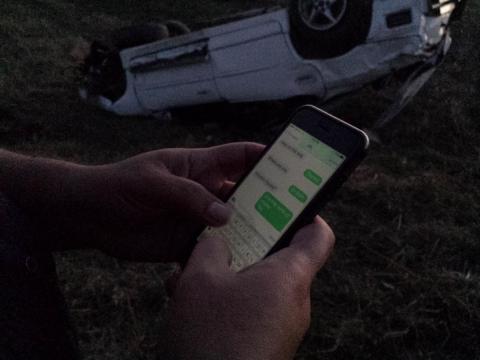9-1-1 Services in North Dakota

Anywhere. Anytime. Any Device.
What is 9-1-1?
911 is the number most people in the U.S. and some in International countries call to get help in a police, fire or medical emergency. A 9-1-1 call goes over dedicated networks to the appropriate 9-1-1 answering point (PSAP) for the caller's location, and trained personnel then send the emergency help needed.
What is Enhanced 9-1-1?
Enhanced 9-1-1, or E9-1-1, is a system which routes an emergency call to the appropriate 9-1-1 answering point (PSAP) for the caller's location, AND automatically displays the caller's phone number and address. In North Dakota and most other areas, the caller’s phone number and location information is available for 9-1-1 calls made from a cellular/wireless phone as well. The 9-1-1 call taker will typically ask the caller to verify the information, which appears on his or her computer screen
Who pays for 9-1-1?
In North Dakota a small monthly fee for 9-1-1 service is added to a customer’s monthly phone or cellular bil – it ranges from $1.00 to $1.50 per month per device. For “pre-paid” cellular phone service, a 2% fee is added to the purchase price at the time of purchase. There is no per-call charge for calling 9-1-1. For most public safety answering points, this service fee is insufficient for the costs of the service, and local governments must contribute general funds for the difference.
When should you use 9-1-1?
Nine-one-one (9-1-1) is only to be used in emergency situations. An emergency is any situation that requires immediate assistance from the police/sheriff, the fire department or an ambulance. If you are ever in doubt of whether a situation is an emergency you should call 9-1-1. It's better to be safe and let the 9-1-1 call taker determine if you need emergency assistance.
Do not call 9-1-1:
- for information
- for directory assistance
- when you're bored and just want to talk
- for paying traffic tickets
- for your pet
- as a prank
If you call 9-1-1 by mistake, do not hang up. Tell the call taker what happened so they know there really isn't an emergency.
What about 9-1-1 prank calls?
It's a prank call when someone calls 9-1-1 for a joke, or calls 9-1-1 and hangs up. Prank calls not only waste time and money, but can also be dangerous. If 9-1-1 lines or call takers are busy with prank calls, someone with a real emergency may not be able to get the help they need. In North Dakota and most other places, it's against the law to make prank 9-1-1 calls.
How do I make a 9-1-1 call?
- In an emergency, dial 9-1-1 on your phone. It's a free call. You can use any kind of phone: push button, rotary, cellular/wireless, cordless, or pay phone.
- Stay calm and state your emergency
- Speak loudly and clearly. Give the 9-1-1 call taker your name, phone number and the address where help is needed.
- Answer the call taker's questions. Stay on the telephone if it's safe to do so, and don't hang up until the call taker tells you to.
What if a 9-1-1 caller doesn't speak English?
When necessary, a 9-1-1 call taker can add an interpreter from an outside service to the line. A non-English speaking caller may hear a short conversation in English and some clicking
Can I send a text to 9-1-1?
Yes, texting to 9-1-1 is available throughout North Dakota for all cellular phone services in the state. For specific information about this service, click on the “Text to 9-1-1” link above.

What if a 9-1-1 caller is Deaf, or hearing/speech impaired?
9-1-1 call takers are trained to answer emergency calls from persons who are deaf, deaf/blind, hard of hearing or speech impaired.
If you use texting on a cellular phone, you should:
- Enter the numbers "911" in the "To" field.
- Text message should be brief and include your location and type of emergency
- "Send" message.
- Be prepared to answer questions and follow instructions from the 9-1-1 personnel.
- Text in simple words - do not use abbreviations
If you use a TTY/TDD, you should:
- Stay calm, using your TTY dial 9-1-1.
- You may receive a quicker response from 9-1-1 by pressing any of the TTY keys a few times.
- Give the call taker time to connect their TTY. If necessary, press the TTY keys again. The 9-1-1 call taker should answer and type "GA" for Go Ahead.
- Tell what type of help is needed-police, fire department, or ambulance. Give your name, phone number and the address or location where help is needed.
- Stay on the telephone if it is safe. Answer the call taker's questions.
If you use a VRS (Video Relay Service) or IP (Internet Protocol) Relay, you should:
- Register and provide your address with the relay provider of your choice. Keep your address updated.
- Be aware that relay calls may take several minutes to connect. If you hang up, your call may not be connected to 9-1-1.
- Be prepared to provide your location information using an address, cross streets or landmarks, especially if you are not at your registered location.
- Your call may need to be transferred to reach the correct 9-1-1 center.
- Stay on the telephone if it is safe. Answer the call taker's questions.
If you do not have a TTY/TDD or access to relay services, you should dial 9-1-1, preferably from a landline phone. With 9-1-1 calls made from a landline phone, the caller's address is displayed on the call taker's screen. Do not hang up; keep the line open so that the call taker can listen for background noise. If you must call from a cell phone, leave the line open. Call from cell phones may display your approximate location.


